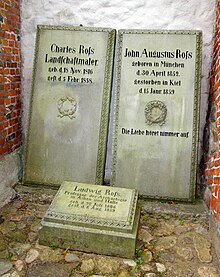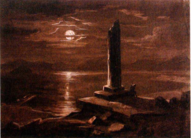Karl Ross
Karl Ross | |
|---|---|
 Painting of the Temple of Poseidon at Cape Sounion by Ross, c. 1840. | |
| Born | Charles Ross November 15, 1816 |
| Died | February 5, 1858 (aged 41) |
| Resting place | Bornhöved |
| Education | Royal Danish Academy of Fine Arts, Copenhagen, Denmark |
| Known for | Landscape painting |
| Notable work |
|
| Spouse |
Helene Abendroth (m. 1847) |
Karl Ross (15 November 1816 – 5 February 1858) (also known as Charles) was a German painter. He is most known for his paintings of Classical landscapes.[1]
Biography[edit]
Ross was born in Ruhwinkel,[2] Holstein, then ruled by the Kingdom of Denmark.[3] His paternal grandfather, a doctor, had moved from northern Scotland to Hamburg around 1750;[4] his father, Colin Ross, married Juliane Auguste Remin[5] and moved in 1810 to the Gut Altekoppel estate in Bornhöved, which he managed and later acquired.[6] Karl Ross was the brother of Ludwig Ross, the classical archaeologist and Ephor General of Archaeology of Greece.[3]
In 1832, Ross travelled to Copenhagen, where he studied at the Royal Danish Academy of Fine Arts until 1834.[2] Among his teachers were Johan Ludwig Lund and Christoffer Wilhelm Eckersberg.[2] He was awarded an academic prize while at the academy, and sold several oil paintings to prince Christian Frederick, the future Christian VIII.[2]
Ross's elder brother, Ludwig, who was then head of the Greek Archaeological Service, invited him to Greece in 1837.[2] Throughout 1837–1839, he travelled through Greece, variously with his brother Ludwig and other central-European expatriates.[7] He made a journey through Attica to Marathon in 1837 with Ludwig and Ernst Curtius, the future excavator of Olympia.[7] He also stayed with Adolf von Shack near Sparta, travelling and painting, and travelled with von Shack to the ancient sites of Ephesus, Magnesia and Smyrna.[8]
Returning to Germany in 1839, Ross travelled to Munich in the August of that year.[8] From November 1842 until late 1843 he lived in Rome, where he befriended the Austrian painter Carl Rahl.[8] However, his visit was cut short by ill health, and he returned for convalescence to his family estate at Gut Altekoppel.[8] He studied in Paris during 1845.[8]
During the attempted uprising against Denmark in 1848, the provisional government of Schleswig, Holstein and Lauenberg sent Ross to Berlin, with a mission of reporting news from the revolt to the Duke of Augustenborg and negotiating assistance from Frederick William IV of Prussia.[9] He took part in meetings of the Provisional Government during April 1848, but played no further part in politics.[9] At the end of the war, he travelled to Munich and then to Rome, after which he settled permanently in Munich from 1851.[9] He is known to have owned Portrait of a Carthusian, a 1446 painting by the Early Netherlandish painter Petrus Christus, until 1854; the painting's ownership history is otherwise unknown until its acquisition by the National Gallery of London in 1857.[10]
Personal life and death[edit]

In 1847, Ross married Helene Abendroth, then aged twenty, whom he had met and taught during his time in Rome.[8] She was the daughter of August Abendroth, who had supported Ross's art career, encouraged his studies abroad and bought many of his paintings.[11]
Ross was affected by ill health throughout his life.[2] He died of typhus on February 5, 1858, in Munich, and was buried in Bornhöved.[12] The author Hermann Lingg wrote his obituary.[12] His wife Helene outlived him, dying in 1911.[8]
Selected works[edit]
-
Die Grotte der Nymphe Egeria bei Rom, 1856.
References[edit]
- ^ Gramm-Lausen 2000.
- ^ a b c d e f Von Donop 1889, p. 243.
- ^ a b Dyson 2008, p. 74.
- ^ The Spectator Supplement, 27 March 1863, p. 19.
- ^ Jahn 1863, p. vii.
- ^ Minner 2006, p. 32.
- ^ a b Goette 2015, p. 219.
- ^ a b c d e f g Von Donop 1889, p. 244.
- ^ a b c Von Donop 1889, p. 245.
- ^ Russell 2020, chapter 7, "Léal Souvenir".
- ^ Gramm-Lausen 2000, pp. 36–38.
- ^ a b Von Donop 1889, p. 246.
Bibliography[edit]
- von Donop, Lionel (1889), "Roß, Karl", Allgemeine Deutsche Biographie (in German), vol. 29, Leipzig: Duncker & Humblot, pp. 243–246
- Dyson, Stephen L. (2008). In Pursuit of Ancient Pasts: A History of Classical Archaeology in the Nineteenth and Twentieth Centuries. New Haven: Yale University Press. ISBN 9780300134971.
- Goette, Hans Rupprecht (2015). "Ludwig Ross in Attica und auf Aegina". In Goette, Hans Rupprecht; Palagia, Olga (eds.). Ludwig Ross und Griechenland: Acten sws Internationalen Kolloquiums, Athen, 2–3. Oktober 2002. Rahden: Marie Leidorf. pp. 219–232. ISBN 978-3-89646-424-8.
- Gramm-Lausen, H. (2000). Charles Roß 1816-1858. Ein Landschaftsmaler des 19. Jahrhunderts. Bau + Kunst. Kiel.
{{cite book}}: CS1 maint: location missing publisher (link) - Jahn, Otto (1863). "Vorwort". Erinnerungen und Mittheilungen aus Griechenland. By Ross, Ludwig. Berlin: Verlag von Rudolf Gaertner. pp. i–xxx.
- Minner, Ina E. (2006). Ewig ein Fremder im fremden Lande – Ludwig Ross (1806–1859) und Griechenland. Biographie. Möhnesee-Wamel: Bibliopolis. ISBN 3-933925-82-7.
- Russell, Peter (2020). Masters of Art: Jan van Eyck. Delphi Classics. ISBN 978-1-913487-28-7. Retrieved 2023-08-29 – via Google Books.
- "Greece and the Greeks". The Spectator Supplement. London. 27 March 1863. Retrieved 2022-12-24 – via Google Books.




